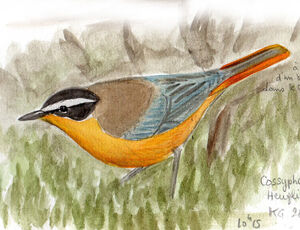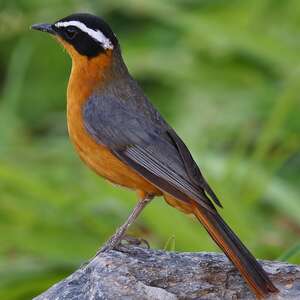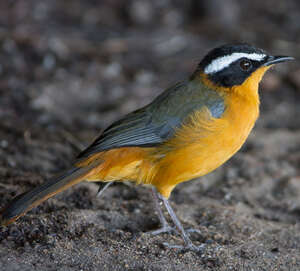White-browed Robin-Chat
Cossypha heuglini - Cossyphe de Heuglin
Identification
White-browed Robin-Chat is a thrush-sized Turdid, with the look of a redstart. The adult is hooded black, with a very distinct white eyebrow from the beak to the nape. What stands out at first sight is the bright orange hue of all the underparts. An orange collar separates the nape from the mantle. The orange colour also reaches the rump, back, uppertail coverts and exterior rectrices, but the latter is largely masked by the wings on the perched bird. The mantle is of an olive-brown colour. The wings and central rectrices are brown with a hint of grey. The iris is dark brown. The fairly strong beak is black and the legs are pinkish to brownish. The subspecies subrufescens is distinguished from the nominate by its black central rectrices. The juvenile has a plumage less defined with less clear colours. Some of the feathers have a slightly scaly look. The head is brown with an almost invisible eyebrow.
White-browed Robin-Chat can be mistaken for Rüppell's Robin-Chat to the north of its range, but the latter is smaller, with wings and central rectrices darker, and it has no complete red collar. It can also look like Blue-winged Robin-Chat to the west, with the adults showing a distinct blue colour on the small closed wing feathers, and whose song includes many imitations of other birds.
Subspecific information 3 subspecies
- Cossypha heuglini heuglini (s Chad and s Sudan south to e Angola, Botswana and n South Africa)
- Cossypha heuglini subrufescens (Gabon to w Angola)
- Cossypha heuglini intermedia (s Somalia along the coast to ne South Africa)
Foreign names
- Cossyphe de Heuglin,
- Cosifa de Heuglin,
- cossifa-mascarada-de-cauda-castanha,
- Weißbrauenrötel,
- szemsávos rozsdásrigó,
- Witbrauwlawaaimaker,
- Cossifa cigliabianche,
- vitbrynad snårskvätta,
- Hvitbryntrosteskvett,
- drozdík stužkatý,
- drozdík bělobrvý,
- Drosselsanger,
- puistopunatasku,
- Heuglinjanfrederik,
- cossifa de Heuglin,
- złotokos białobrewy,
- Белобровая чекановая горихвостка,
- マミジロツグミヒタキ,
- 白眉歌䳭,
- vitbrynad snårskvätta,
- 白眉歌鵖,
Voice song and call
The song of the White-browed Robin-Chat is renowned for its power and musicality. This one does not break from the rule. The strophes are quite short but melodic, with a deep timbre with oriolid-like inflections. It usually starts softly then gains progressively in volume. Usually it contains few imitations. The two sexes talk to each other. The female interposes high-pitched tseeees between the phrases of the male. The calls are varied and hard to transcribe. In their repertoire one can distinguish contact calls of yup. Alarm calls include low creaks and imitations of alarms of other species like bulbuls.
Habitat
White-browed Robin-Chats frequent the edges of evergreen forests and thickets. These are particularly favored when they have termite mounds and a broken canopy along the riverbanks.
In East Africa, White-browed Robin-Chats live from sea level up to 2,200 meters. In other African regions, they occupy sites up to 2,300 meters, except for south of the Limpopo River where they do not reach higher than 1,000 meters.
Behaviour character trait
White-browed Robin-Chats are quite discreet and can easily go unnoticed if not for the powerful song of the males.
They spend a lot of time on the ground, quickly progressing in leaps and having frequent stops. On the ground, they mainly look for their food by turning over the leaf litter with their beak. They also capture winged insects like termites during brief aerial pursuits. But they also willingly perch in the woody plants of the understory and it is from there that males sing, quite hidden in the foliage.Dietfeeding habits
White-browed Robin-Chats mainly consume insects, particularly ants and beetles. However, the diet also includes fruits.
From a sample of about 20 stomachs examined, 86% contain ants (4 different families), 75% beetles (9 families, including ladybugs, tenebrionids, curculionids and many other phytophagous insects, as well as buprestids in regions where farming is practiced), and 32% caterpillars. The remainder of the menu consists of unidentified fruits, bugs, wasps. Spiders, pillbugs, flies, millipedes and small tree frogs constitute a very small proportion.Reproduction nesting
In East Africa, the nesting season generally coincides with the rainy season (April-May and November-January), while in equatorial regions, including around Lake Victoria, it has a tendency to take place throughout the year.
Other dates are June in Ethiopia and September-February in regions south of 10° south latitude. There can be two broods per year.During the breeding season, White-browed Robin-Chats usually make a territory of about 1 ha, though its size can vary depending on the quality of the habitat. In a week, the couple builds an open-cup-shaped nest with dead leaves and coarse twigs. It is lined with moss, rootlets, grass stalks and elephant grass. The structure is situated in a crevice or a tree cavity, on a shrub branch, less than 2 meters above the ground. In a bamboo thicket, it is set up to 8 meters.
Sometimes old nests are repaired and reused after some minor renovations.
The clutch contains 1 to 3 eggs, which are milky brown, olive-fawn, cream or bluish in color, sometimes with reddish brown spots. Incubation time gets longer as it goes south of the range (12 days in Kenya and up to 17 days in Natal).
After fledging, the chicks remain dependent on the family for 3 to 4 weeks. The nests are parasited by the cuckoo and regularily predated by cats and arboreal snakes (Dispholidae). Despite these rather common hazards, the success rate to adulthood is 83%, which is an excellent score.
Geographic range
White-browed Robin-Chat is widely distributed in Africa, ranging from southern Chad and the Sudan to northeastern South Africa in latitude, and from Angola to Mozambique in longitude.
C. h. subrufescens - Gabon to western Angola.
C. h. heuglini - Southern Chad, southwest Sudan, northwest Central African Republic eastwards across Ethiopia, south to east Angola, north Botswana, Zimbabwe and north South Africa.
C. h. intermedia - Southern Somalia and the entire east coast of Africa to Natal.
Threats - protection
IUCN conservation status
concern
in the Wild
threatened
evaluated
The White-browed Robin-Chat is rare but locally common across its African range. Density, for example, is 3 birds per hectare in South Africa (Natal). The species is not currently threatened. Since the 1950s, it has been steadily, even slowly, expanding its range to the south.
Sources of information
- IOC World Bird List (v15.1), Gill, F and D Donsker (Eds). 2025-12-07.
- Birds of Southern Africa 3rd edition, Ian Sinclair
- Birds of Western Africa, Nick Borrow and Ron Demey
- ARKive, Christopher Parsons
- Avibase, Lepage Denis
- BirdLife International, BirdLife International
- HBW Alive,
- Wikipedia (English version),
Other sources of interest
 Specification sheet created on
28/10/2023 by Daniel Le-Dantec
Specification sheet created on
28/10/2023 by Daniel Le-Dantec partially rewritten on 00/00/0000 by Jean François
Translation by AI Oiseaux.net
© 1996-2025 Oiseaux.net
- Accipitriformes
- Aegotheliformes
- Anseriformes
- Apodiformes
- Apterygiformes
- Bucerotiformes
- Caprimulgiformes
- Cariamiformes
- Casuariiformes
- Charadriiformes
- Ciconiiformes
- Coliiformes
- Columbiformes
- Coraciiformes
- Cuculiformes
- Eurypygiformes
- Falconiformes
- Galliformes
- Gaviiformes
- Gruiformes
- Leptosomiformes
- Mesitornithiformes
- Musophagiformes
- Nyctibiiformes
- Opisthocomiformes
- Otidiformes
- Passeriformes
- Pelecaniformes
- Phaethontiformes
- Phoenicopteriformes
- Piciformes
- Podargiformes
- Podicipediformes
- Procellariiformes
- Psittaciformes
- Pterocliformes
- Rheiformes
- Sphenisciformes
- Steatornithiformes
- Strigiformes
- Struthioniformes
- Suliformes
- Tinamiformes
- Trogoniformes
































